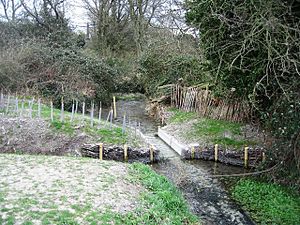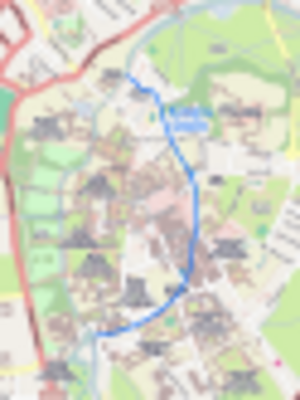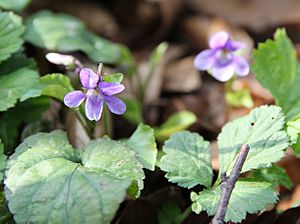Nine Wells facts for kids
Quick facts for kids Nine Wells |
|
|---|---|
 |
|
| Type | Local Nature Reserve |
| Location | Trumpington, Cambridgeshire |
| OS grid | TL 461 542 |
| Area | 1.2 hectares |
| Managed by | Cambridge City Council |
Nine Wells is a special natural area, like a small park, located just outside Cambridge, near a village called Trumpington. It's a Local Nature Reserve, which means it's protected for its wildlife and natural beauty. The Cambridge City Council looks after this 1.2-hectare site.
Nine Wells is a small woodland area surrounded by farms. Many natural springs bubble up from the bottom of a chalk hill here. These springs feed a famous waterway called Hobson's Conduit. This conduit was built a long time ago, between 1610 and 1614, by Thomas Hobson and others. Its purpose was to bring clean, fresh water into the city of Cambridge. There are four main springs connected by small streams, plus many tiny cracks where water comes out. The water from these springs is always a cool 10.2 °C!
Contents
A Glimpse into Nine Wells' Past
In 1265, a defensive channel called 'the king's ditch' was dug around the city of Cambridge. By the early 1600s, this ditch had become very dirty. In 1574, a man named Andrew Perne had an idea. He thought of building a channel to bring fresh water to clean the ditch.
This idea led to the creation of Hobson's Conduit, which started being built in 1610. It used the natural springs at Nine Wells to create a flow of water into the city. This not only cleaned up the dirty ditch but also became the main water supply for Cambridge for over 250 years! Even today, water from Nine Wells still flows into the city and helps fill the lake in the Botanic Gardens.
Plants and Trees at Nine Wells
The main trees you'll see here are beech trees. They were originally planted for firewood. However, their leaves can make the water in the streams more acidic when they fall in autumn. This can cause mud to build up and change the oxygen levels in the water.
The hedgerow, which is like a living fence around the reserve, was planted after the Enclosures Act of 1834. It has native plants like hawthorn, spindle, and field maple. A study found that 108 different plant species grow here! You can also find many old ash trees and blackthorn. Early in the year, you might spot sweet-smelling sweet violets (Viola odorata) and bluebells. Later, cowslips bloom, and you might even see deadly nightshade.
Amazing Aquatic Wildlife
Nine Wells was once a very special place for tiny water creatures. It was even named a biological Site of Special Scientific Interest (SSSI) because of the rare aquatic invertebrates that lived and reproduced here. Some flatworms, like Planaria cornuta and P. alpina, were found here. They had survived since the last ice age! Another rare insect was a caddisfly called Agapetus fuscipes.
However, a big drought in 1976 and more water being taken from the springs caused some of these creatures to disappear. Because of this, Nine Wells lost its SSSI status. People are now working hard to make the streams healthy again so these special invertebrates can return. There's a lot of new building happening nearby, which could threaten this unique habitat.
Information boards at the reserve explain that the streams need to be actively managed. This helps fish like bullheads to thrive, which are important food for kingfishers. It's also important to clear fallen beech leaves from the streams to stop the water from becoming too acidic.
Animals of the Woods
These woods are a home for many different bird species. You might see chaffinches, robins, yellowhammers, greenfinches, and blackbirds. In the summer, chiffchaffs also visit.
Nine Wells is an important safe place for birds. Birds like the sparrowhawk (Accipitier nisus), green woodpecker (Picus viridis), long-tailed tit (Aegithalos caudatus), bullfinch (Pyrrhula pyrrhula), and redwing (Turdus iliacus) have been seen here. There's also a good variety of smaller birds. It's also a great spot for butterflies, including beautiful peacocks and brimstones (Gonepteryx).
The Hobson's Conduit Monument
Inside the reserve, there's a monument dedicated to Hobson's Conduit. It was put up in 1861 by public donations. The monument lists the people who helped fund the water course and conduit:
- Thomas Chaplin, who owned the land in Trumpington Delapole, in 1610
- Stephen Perse, a fellow at Gonville and Caius College, in 1615
- Thomas Hobson, a carrier, in 1630
- Edward Potto, an alderman (a type of city official) of Cambridge, in 1632
- Joseph Merrill, also an alderman of Cambridge, in 1806
Finding Nine Wells
Nine Wells is located south of Addenbrooke's Hospital and east of the railway line. You can find it near the village of Great Shelford, close to the genome cycle track (52°09′58″N 0°08′06″E / 52.166°N 0.1349°E).
Gallery
-
The Double Helix sculpture where National Cycle Route 11 meets the track along Hobson's Brook leading to Nine Wells








